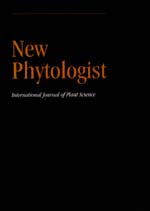Crossref Citations
This article has been cited by the following publications. This list is generated based on data provided by
Crossref.
Fransson, Petra M. A.
Taylor, Andrew F. S.
and
Finlay, Roger D.
2001.
Elevated atmospheric CO2 alters root symbiont community structure in forest trees.
New Phytologist,
Vol. 152,
Issue. 3,
p.
431.
Koide, Roger T.
and
Kabir, Zahangir
2001.
Nutrient economy of red pine is affected by interactions between Pisolithus tinctorius and other forest‐floor microbes.
New Phytologist,
Vol. 150,
Issue. 1,
p.
179.
Landeweert, Renske
Hoffland, Ellis
Finlay, Roger D.
Kuyper, Thom W.
and
van Breemen, Nico
2001.
Linking plants to rocks: ectomycorrhizal fungi mobilize nutrients from minerals.
Trends in Ecology & Evolution,
Vol. 16,
Issue. 5,
p.
248.
Rillig, Matthias C.
Treseder, Kathleen K.
and
Allen, Michael F.
2002.
Mycorrhizal Ecology.
Vol. 157,
Issue. ,
p.
135.
Brussaard, Lijbert
Kuyper, Thomas W.
and
de Goede, Ron G.M.
2002.
Interactions in the Root Environment: An Integrated Approach.
p.
155.
Staddon, P. L.
Heinemeyer, A.
and
Fitter, A. H.
2002.
Diversity and Integration in Mycorrhizas.
p.
253.
Taylor, Andy F. S.
Fransson, Petra M.
Högberg, Peter
Högberg, Mona N.
and
Plamboeck, Agneta H.
2003.
Species level patterns in13C and15N abundance of ectomycorrhizal and saprotrophic fungal sporocarps.
New Phytologist,
Vol. 159,
Issue. 3,
p.
757.
Heijden, E. W. van der
and
Kuyper, Th. W.
2003.
Ecological strategies of ectomycorrhizal fungi of Salix repens: root manipulation versus root replacement.
Oikos,
Vol. 103,
Issue. 3,
p.
668.
Hoeksema, Jason D.
and
Kummel, Miroslav
2003.
Ecological Persistence of the Plant‐Mycorrhizal Mutualism: A Hypothesis from Species Coexistence Theory.
The American Naturalist,
Vol. 162,
Issue. S4,
p.
S40.
2003.
Fungi in Ecosystem Processes.
Matyssek, R.
Agerer, R.
Ernst, D.
Munch, J.-C.
Oßwald, W.
Pretzsch, H.
Priesack, E.
Schnyder, H.
and
Treutter, D.
2005.
The Plant's Capacity in Regulating Resource Demand.
Plant Biology,
Vol. 7,
Issue. 6,
p.
560.
Finlay, R.
2005.
Nutrient Acquisition by Plants.
Vol. 181,
Issue. ,
p.
221.
Alberton, Odair
Kuyper, Thomas W.
and
Gorissen, Antonie
2005.
Taking mycocentrism seriously: mycorrhizal fungal and plant responses to elevated CO2.
New Phytologist,
Vol. 167,
Issue. 3,
p.
859.
Fransson, Petra M. A.
Taylor, Andy F. S.
and
Finlay, Roger D.
2005.
Mycelial production, spread and root colonisation by the ectomycorrhizal fungi Hebeloma crustuliniforme and Paxillus involutus under elevated atmospheric CO2.
Mycorrhiza,
Vol. 15,
Issue. 1,
p.
25.
HOEKSEMA, J. D.
and
THOMPSON, J. N.
2007.
Geographic structure in a widespread plant–mycorrhizal interaction: pines and false truffles.
Journal of Evolutionary Biology,
Vol. 20,
Issue. 3,
p.
1148.
Alberton, Odair
Kuyper, Thomas W.
and
Gorissen, Antonie
2007.
Competition for nitrogen between Pinus sylvestris and ectomycorrhizal fungi generates potential for negative feedback under elevated CO2
.
Plant and Soil,
Vol. 296,
Issue. 1-2,
Anderson, Ian C.
and
Cairney, John W.G.
2007.
Ectomycorrhizal fungi: exploring the mycelial frontier.
FEMS Microbiology Reviews,
Vol. 31,
Issue. 4,
p.
388.
Parrent, Jeri Lynn
and
Vilgalys, Rytas
2007.
Biomass and compositional responses of ectomycorrhizal fungal hyphae to elevated CO2 and nitrogen fertilization.
New Phytologist,
Vol. 176,
Issue. 1,
p.
164.
Cudlin, P.
Kieliszewska-Rokicka, B.
Rudawska, M.
Grebenc, T.
Alberton, O.
Lehto, T.
Bakker, M. R.
Børja, I.
Konôpka, B.
Leski, T.
Kraigher, H.
and
Kuyper, T. W.
2007.
Fine roots and ectomycorrhizas as indicators of environmental change.
Plant Biosystems - An International Journal Dealing with all Aspects of Plant Biology,
Vol. 141,
Issue. 3,
p.
406.
Fransson, Petra M. A.
Anderson, Ian C.
and
Alexander, Ian J.
2007.
Does carbon partitioning in ectomycorrhizal pine seedlings under elevated CO2 vary with fungal species?.
Plant and Soil,
Vol. 291,
Issue. 1-2,
p.
323.


